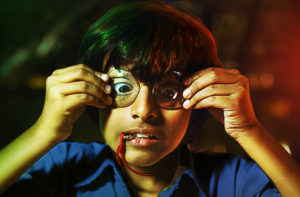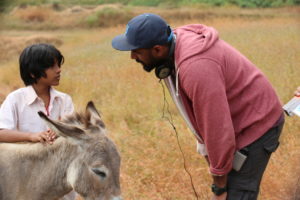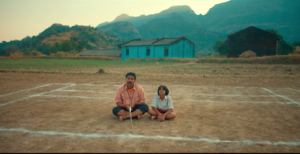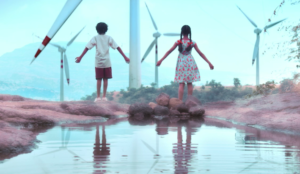Nachiket Samant’s ‘Habaddi’ opens the Indian Film Festival of Melbourne 2020

By Neeru Saluja
Award winning Indie filmmaker and writer Nachiket Samant believes in exploring uncharted water when it comes to content. His latest film ”˜Habaddi’ is based on a 12 year old boy with a speech defect who sees joining his village school’s Kabaddi team as an opportunity to visit his love in Mumbai.
Set in a quaint, Kabaddi-crazy village near Kolhapur, Habaddi is a funny story about a 12-year old orphan called Manya, with one amazing gift and one gigantic defect.
Calling it the story of an underdog, the Marathi film is all set to open to the Indian Film Festival of Melbourne 2020. We talked to the director before the opening of the festival to know more about the making of the film.
The story of ”˜Habaddi’ is loosely based on your orphan brother. How did you fabricate the story around the main protagonist?
My parents adopted my orphan brother from a small town of India and saw a spark in him. He was super smart but was under confident with a feminine voice. This complex withheld him from talking and socialising with people. But he was amazing with fixing things, and it could have stemmed from his broken upbringing. I chose kabaddi as a sport due to it’s audio-visual aspect as while playing the sport you have to repeat the word ”˜kabaddi, kabaddi, kabaddi’. Therefore, I decided to place the protagonist in a space where he had to play kabaddi, is agile and has a disadvantage as he stutters.

When you were making this film, did you also intend to highlight or address the issue of bullying, superstitions and obsession with a sport?
I didn’t have the intention of addressing the issue from a social reform perspective. I included everything that happens in such a scenario. I wanted to follow the fantasies of this child in his imaginary world. He is an escapist, running away from his problems and that’s what I wanted to focus on.
Your storytelling is in the form of tragicomic storytelling and you are a fan of Chaplin. Tell us more about this.
I do not believe in letting out the story as it is. I believe in making a film where you can find light even in tragic circumstances. It’s a village story and I’m an urban lad. I was born in Mumbai but brought up in Pune, and travelled often to the village from where my brother was adopted. My outlook was also from an outsider angle. That is why I picked a more realistic way of telling the story and this form suited the story.
The underwater sequences were a visual delight ”“ did you have any imagery in mind before shooting those scenes and did you face any challenges?
The underwater scenes represented the innermost fears of the protagonist. We did not have any imagery in mind except for the ghost, which was modelled on a friend of mine. There were lots of challenges we faced though. We did ask the main actor if he knew how to swim. But it was basic skills. So we trained him for swimming. Then later, we realised we had not trained him for scuba diving! So we spent six months training him. In that time, he had a growth spurt and then we had to work around another challenge! Due to budget constraints, it took us a lot of time to shoot the scenes.
Talking about budget, it seems like for independent filmmakers small budget films that are high in content are the way to go. Does having these films being shown in festivals or OTT platforms in comparison to cinematic releases give you a platform for your voice to be heard?

This has been happening for quite a while. For eg, in Marathi cinema the audience is not only loyal to Marathi films as they understand Hindi. It is also content driven not star driven. This is the way forward, getting recognition via international film festivals and then coming back home for cinematic releases. OTT platforms have also become a viable circuit.
In the end, I just want to tell a story and as long as it finds an audience in any form, I’m ok with it. 2020 is a big lesson for all of us! It took us two years to shoot this film and the pandemic hit us once we were ready to release it. Now films are going to be fighting for cinematic releases.

The mantra of Yoodlee films that has released your film is ”˜fearless filmmaking’. What does that mean to you?
My film was the first one to be released via Yoodlee Films. I presented ”˜Habaddi’ to them and they liked it. There is no face value in this film in term of stars. Child actors cannot be stars. I would have struggled otherwise. They believe in a good story and high content. That’s what they mean about fearless filmmaking.
What’s next for you as a filmmaker?
While I was wondering when to release ”˜Habaddi’, I signed up for another film with Yoodlee. It was shot and produced during the pandemic within four months. It is called ”˜Comedy Couple’ starring Saqib Saleem and Shweta Basu Prasad and was released yesterday on Zee5. It has been an intense four months and now I’m looking forward to a break!
All films will be available for viewing free of charge across Australia from October 23 to 30. In recognition of the pressures this year has placed on many people, IFFM is partnering with Mental Health Foundation Australia and encourages festival participants to make a donation when booking.
The IFFM program will also include a selection of films from the 2020 IFFM Short Film Competition, which this year received more than 3000 entries. The winner will be announced on the final day of the festival.
To view the Festival program go to Iffm.com.au
Short URL: https://indiandownunder.com.au/?p=15538
